7 Ways to Market Rental Properties Online in 2016
What’s the one word that keeps every landlord awake at night? Vacancy.
Every day that a rental property sits empty it costs you money. The income dries up. No one is paying you rent. You have to spend money marketing the property to reach new prospective tenants. Then, there are all those hours spent screening dozens of applicants, only to find out most, if not all, of them are a “no-go.”
The whole process can be emotional, tedious, tiring, and downright infuriating at times. Until today. In this post I’m going to share seven online strategies our property management company uses to maintain average occupancy rates above 98% across 400 rental properties in east Idaho.
Whether you’re a landlord managing a single residential property or a company with a large investment portfolio, this list of marketing tactics will help you build a strong online presence, attract quality tenants, and fill your rentals fast.
#1: Internet Listing Sites (ILS)
80% of renters start their search online.
Do a quick search for a rental property in your local area and you’ll likely see a page that looks something like this:
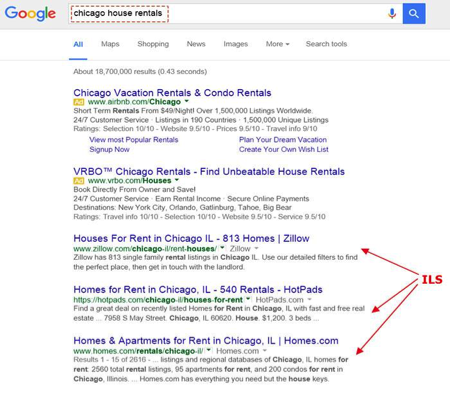
In the absence of local search listings, you’ll notice the majority of the first page positions are occupied by major brands like Zillow, Hotpads and Homes.com. Each website attracts millions of visitors each month; and most of these people are either looking for a place to rent or buy.
Think of it as a large pool of warm traffic. Create a free listing and gain immediate visibility for your property.
Note: Most listing sites provide paid ad services to get additional exposure (but not guaranteed leads, so you might be paying for nothing) by placing rental properties at the top of targeted searches. For example, you pay a monthly fee to have your property show in the top 3 results for “Chicago 3 bedroom apartment.” [See how AppFolio can cut out this expense with Premium Leads.]
Here is a list of the top sites to list your rental units. Go to each site and create a free profile. Upload some photos and fill out all the details. In a matter of minutes your property will be searchable by hundreds, maybe thousands of people looking for rentals in your area.
If this sounds like a lot of work, software like AppFolio can feed your listings to these sites in a single click.
#2: Email List
An email list is one of the most valuable assets of any online business. On average, 1-2% of the people that land on your site fill out a rental application, schedule a walk-through or complete some other type of online conversion.
Let me re-phrase that: 98% of the people visiting your website leave without doing one of these important things. Let that sink in nice and deep. Now let me ask: What are you doing to re-engage all that warm traffic, the people actively searching for a rental?
If you answered “nothing,” you’re not alone. In fact, you’re far from it. Most visitors will abandon your site for one of two reasons:
- They aren’t ready to apply for a new property yet.
- They didn’t find a property they liked.
You can’t let these people slip away without first trying to collect their contact information so you can re-engage with them at a later date. The best way to do this? Build an email list.
Here is what it looks like on our rental listing page:
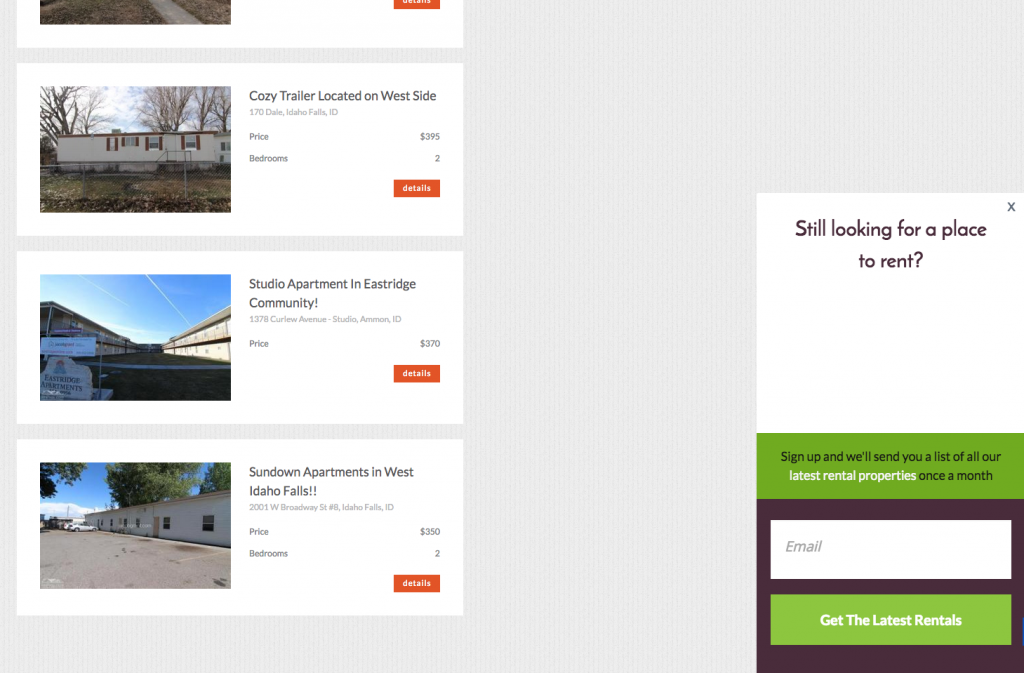
As people scroll down to the bottom of the page a form slides in from the side asking people if they want to be updated each month about new rental listings. But, what if they aren’t looking for a place to rent when you send the email?
Give subscribers an opportunity to share the property on social media or forward it to a friend.
At the very least, you’ll have ongoing communication with the subscriber, and as their lease draws to a close you’ll be top of mind when it comes to finding a new place to rent.
#3: Local SEO
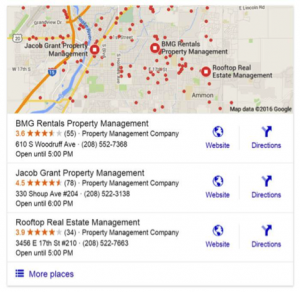
Search engine optimization (SEO) helps a website to rank in the search engines (Google, Bing etc.) for target keywords. Why is this important?
A couple reasons come to mind:
1. More than 80% of renters start their search online.
2. Search intent.
Think about it. When someone goes to Google and types in “Idaho Falls house rentals” you know that person is actively searching for a new place to rent in that specific geographic location.
Our company focuses heavily on local SEO. You can see below that we now rank high for local rental-related search terms:
Organic traffic now brings in over 4,800 visits a month to our website. That’s a LOT of qualified traffic.
Note: Idaho Falls only has 50,000 people.
#4: Craigslist
Craigslist technically falls under the ILS category. But, due to the fact that the site is often one of the first places a person goes to search for a place to live, I thought it deserved it’s own spot on the list.
The site is free, integrates with other major ILS sites, and provides simple location-based search functionality that increases the odds you will be reach targeted prospective tenants.
A couple years ago the site removed the ability to create enhanced listings, which made it more difficult to drive traffic and leads from the site. What changed?
Craigslist stopped supporting HTML tags that were once used to style listing pages and create a rich media experience for the user. Live links were disabled which meant users had to manually copy the link and paste it into the browser search bar. This significantly reduced referral traffic from the site, and skewed analytics data.
For example, in 2013 Craigslist accounted for 92% of our site’s “referral” traffic. Fast forward to 2015, and the platform is attributed with only 0.62% of total referral traffic.
To clarify, this is not a direct indication of the drop off in traffic actually coming from the platform, but since people need to copy and paste the URL from the listing ad into their browser the traffic is now attributed to a “Direct” referral in Google Analytics.
We talk more about these changes and how property owners can still leverage Craigslist to capture qualified leads over at jacobgrant.com.
#5: Facebook Advertising
Facebook has over 1 billion users. Due to the amount of information collected from users, the site offers a very robust and targeted ad platform. There are a million and one different ways you can leverage the platform to market rental properties, but here are a couple ways to get you started.
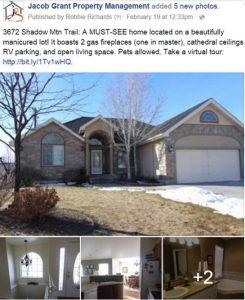
Boosted posts
This one is simple. Create a post that includes some quality images, a detailed description, call-to-action and link to the individual listing page:
When the post is live, click the “Boost Post” button. Next, set your targeting. Make sure at a minimum you are targeting by location. Then set your budget. This does not need to break the bank. For example, we usually run ads over the weekend for $10-15 that generate 200+ referral visits. That’s a cost-per-click of less than $0.05.
Retargeting
People rarely convert the first time they visit your site or see an offer. In fact, it usually takes an average of seven touch points before a consumer will convert. Rentals aren’t that different.
A prospective tenant will likely visit your website, check out all the rental properties and leave to “shop” around for a better property based on price, location, amenities, or a number of other factors. Your job is to stay in front of these people and bring them back to your site to convert.
The best way to do this is retargeting. In this case, we’re referring to showing ads to people who have already visited a particular page on your website.
To create a targeted audience based on website visitors, you must have a Facebook website custom audience in place. When someone visits a page with custom audience code on it, they are added to an audience list in the Facebook Ads Manager. This list continues to build over time. You can then use the list as a target audience in ad campaigns.
For example, we have a custom audience built that contains all the people who visit our rental listings page:
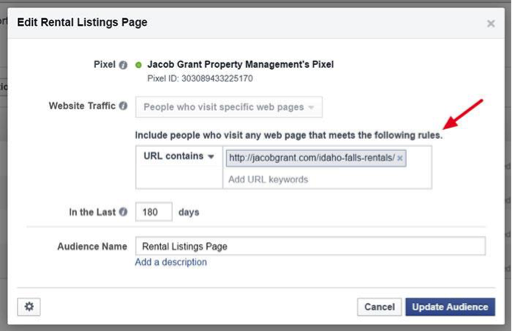
After someone visits our listing page AND doesn’t convert we remarket to them on Facebook by showing new listings over the next 1-2 weeks. The results?
Last month we spent just $40 on Facebook ads. The link in one of the ads was clicked over 200 times. We use bit.ly to shorten Google tracking URLs and monitor link clicks. And, the ads generated 8 online rental applications. Each application has a $25 value.
This social media marketing strategy is very simply, and easily scalable. Give it a try.
#6: YouTube
If a picture is worth a thousands words, a video is worth a million. Choosing a place to live is a big decision. Make it as easy as possible for prospective tenants to evaluate the rental property.
One of the best ways to do this is to offer a virtual tour of the property. Prospective renters are able more easily picture themselves living in the property if someone else is walking them through it.
This does not have to be an expensive or super time-consuming process. In fact, it can be done on a smartphone. Simply create a free YouTube channel, film a walk-through of the property, upload the video and embed it on the list page.
Bonus: Some people find your property while surfing YouTube. Use YouTube cards to channel traffic to your website. They allow you to add a call-to-action in video overlays.
You can also promote the walk-throughs on Facebook and other social media channels.
#7: User Experience
Getting qualified traffic to your website is only half the battle. What really matters is that you are converting those visitors once they land on your site.
For a landlord or property management company this usually means getting people to fill out some type of online rental application. In order for a prospective tenant to fill out a form they often need to have a great user experience. What does this mean? In a nutshell, the user is able to easily find all the information they need to make a decision.
Here are 5 optimization points to focus on:
- Easy navigation — If you have multiple properties, make it easy for users to search and filter properties.
- Pictures— Make sure the user can view high-quality photos of each room in the home.
- Details— Make a list of all the property details past renters have asked for, and include them in the description. Most renters will want information about pricing, deposits, application fees, square footage, utilities and pet policy. Always include a map of property locations, and a virtual tour video (if possible).
- Call-to-Action — Allow users to apply or schedule a walk-through of the property online.
- Mobile-friendly — Take a look at your analytics and you’ll likely see that around 50% of your traffic is coming from a mobile or tablet device. Google even gives preference to sites that are mobile-optimized. So, if you want to improve your chances of ranking in local search results, and increase conversions, make sure your website is mobile-friendly.
There you have it, seven ways any property management company can generate more online traffic and renter leads.
What other strategies are you using to fill your rental properties? Let us know in the comments below.
Robbie Richards is a member of the marketing team at Jacob Grant Property Management. The company manages over 400 rental properties across east Idaho. Learn the strategy they use to maintain average occupancy rates above 98% year-round here.
The post 7 Ways to Market Rental Properties Online in 2016 appeared first on The Official AppFolio Blog.
Tags: AppFolio




